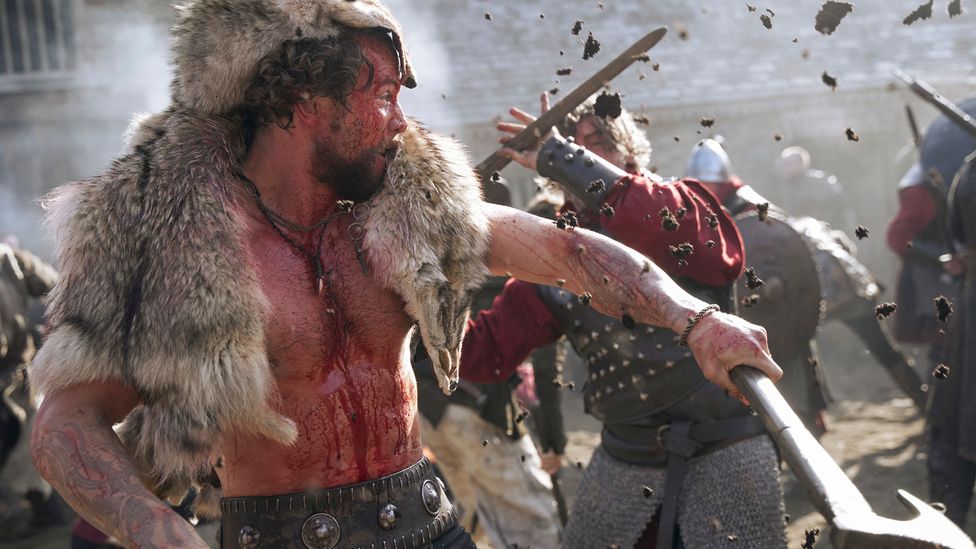As Vikings: Valhalla premieres on Netflix, Luke Walpole explores how images of marauding pagans are misleading – despite being part of the popular imagination since the 8th-Century Anglo-Saxon Chronicle.
Y
You've probably heard the story by now. It's the late 8th Century, and just off the coast of Northumbria in England, Lindisfarne Priory acts as a beacon of Christianity peering into the North Sea. Yet soon, according to lore, that tranquillity will be replaced by blood and thunder. The year is 793 AD and the Vikings are about to explode onto the historical stage.
Reflecting on the year, the Anglo-Saxon Chronicle – a compendium of historical documents that underpins our understanding of medieval England – notes: "This year came dreadful fore-warnings… terrifying the people most woefully: these were immense sheets of light rushing through the air, and whirlwinds, and fiery dragons flying across the firmament."
More like this:
- The buried ship found on an English estate
- The ancient figure challenging China's history
- The 2000-year-old Wonder Women
The image of the Vikings that would continue in the popular imagination was established then. As the Chronicle continues, soon after, "the harrowing inroads of heathen men made lamentable havoc in the church of God in Holy-island, by rapine and slaughter". The Vikings were here in all their terrifying, pagan glory, and would remain key to the history of western Europe until the late 11th Century (even if the name "Viking" itself was not coined until well into the 19th Century, likely drawing upon the Old Norse word Víkingr and the Anglo-Saxon word Wicing).
Etymology aside, the Anglo-Saxon Chronicle's depiction of Vikings has stuck. Later, in 865 AD, "the heathen army" arrived in Thanet, "stole up the country, and overran all Kent Eastward". From here, they went on to establish dominion across swathes of the midlands and East Anglia – thereafter known as Danelaw.
By the 13th Century, much of the contents of Vikings' oral storytelling tradition had been written down by Norse settlers in Iceland, even if this cohesive sense of "Vikingness" is a much more modern imposition. These tales – initially recorded in poem collections called Eddas – lyrically describe the pantheon of Gods, such as Odin, Thor and Loki, who have recently become wholly sanitised by Marvel.
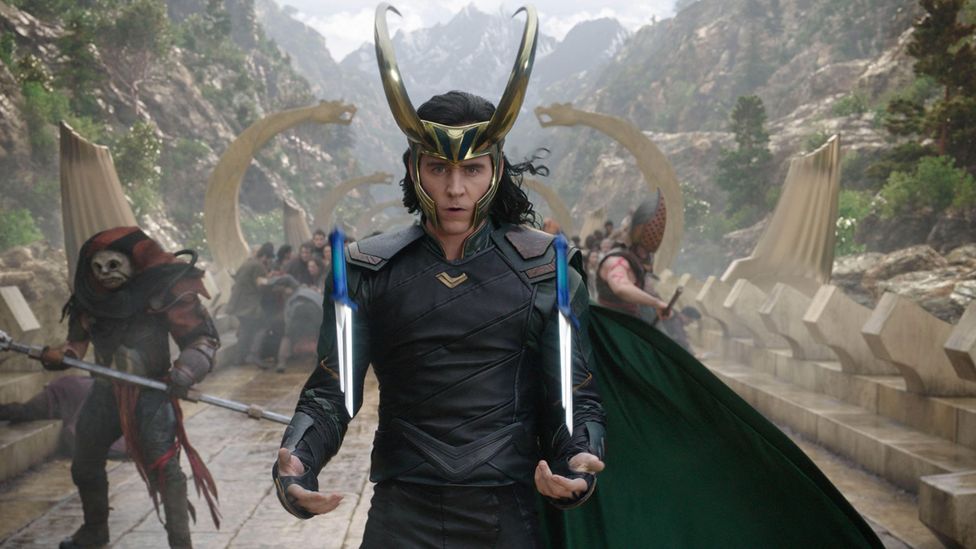
Tom Hiddleston stars as Loki in the 'Marvel Cinematic Universe' (Credit: Walt Disney Studios)
The Icelandic Sagas are less flowery in language – though still full of fantastical elements – and were designed to capture the epic deeds of Viking forefathers. The sons of Ragnar Lothbrok, including the delightfully named Ivar the Boneless, play a huge role in them, and the Ragnar Saga Lodbrokar formed the basis for The History Channel's wildly successful show Vikings, which lasted for six seasons from 2013 to 2020. A sequel, Vikings: Valhalla, premieres on Netflix this Friday – continuing the story of the Norsemen while introducing real-life heroes such as Leif Erikson, who is believed to have travelled all the way to North America. According to The Wrap, "Vikings: Valhalla has a narrative elegance and drive without sacrificing the pillaging, passionate sex, pagan rituals and political intrigue".
Echoes of the Sagas are also felt throughout Assassins' Creed: Valhalla (2020), a counterfactual spin on the "Great Heathen Army", which has become the biggest selling instalment in the long-running videogame series. While the impact of lockdowns across the world may have been a factor in its success, it also reflects an ongoing fascination with the heady mix of violence and pagan mysticism that have come to define the Viking era. From the horn-helmeted raiders of Richard Wagner's 1874 opera cycle Der Ring des Nibelungen to the bloodthirsty men of the 1958 epic historical film The Vikings and Bernard Cornwell's recent novel series The Last Kingdom, the image of fierce, adventurous Norsemen has seeped into our collective consciousness.
This is set to continue. As well as Vikings: Valhalla, this spring sees the big-screen release of Robert Eggers' The Northman, a revenge tale in which the film's lead Amleth (Alexander Skarsgård) ominously promises: "I will avenge you father. I will save you mother. I will kill you Fjölnir," an aphorism that captures the classically savage view of the Vikings.
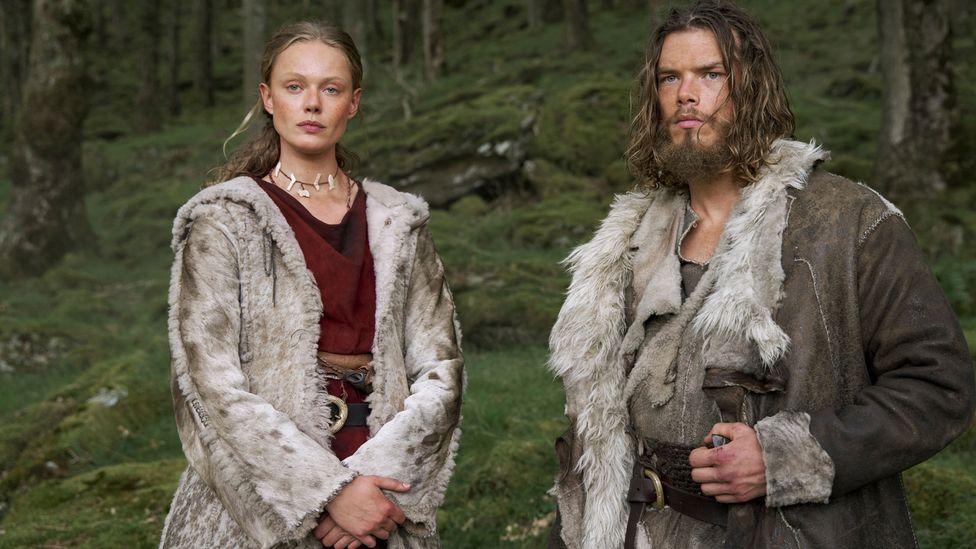
In Vikings: Valhalla, Sam Corlett and Frida Gustavsson play siblings Leif and Freydis Eriksson navigating the Northern seas from Greenland to Denmark (Credit: Netflix)
This iconography has long held sway in the political sphere. The idea of a tall, strong, blonde-haired and blue-eyed Nordic race was one that came to underpin the Nazis' Aryan ideal and cemented the subsequent right-wing fascination with the Norsemen. Interestingly, JRR Tolkien, whose Middle-earth draws heavily upon the Sagas and Eddas, admonished "that ruddy little ignoramus Adolf Hitler" for "ruining, misapplying, and making forever accursed, that noble northern spirit."
The Vikings have also featured amid the ongoing political tensions in Ukraine, folded into a debate about origins of the Russian and Ukrainian states. Between the 8th and 11th Centuries, it is generally accepted that groups of Swedish travellers and soldiers – and therefore what we would deem Vikings – seized and settled in areas surrounding the river routes between the Black and Caspian seas. Through this, they came to be known as the Kyivan Rus’, a group commonly held to be the progenitors of modern-day Russia, Ukraine and Belarus. Yet the influence of Scandinavians in this is hotly contested. Indeed, an extraordinary 2021 historical essay by the Russian president Vladimir Putin wholly omits the Scandinavians and claims that "Russians and Ukrainians were one people – a single whole."
A different direction
Politics aside, the basis of Western culture's understanding of the Vikings is predicated on a male-dominated focus on the Viking's Western expansion, and less of a glance East. This is perhaps surprising, given some of our key reflections of the Vikings come from Middle Eastern historical sources, and the increasing number of Islamic artefacts which are being found across Scandinavia and indeed Britain. For example, Ahmad ibn Fadlan was a 10th-Century chronicler from the Abbasid Caliphate, who encountered a group of Rus'. Fascinated, he noted that while "they are the filthiest of God's creatures… I have never seen more perfect physical specimens, tall as date palms, blonde and ruddy... Each man has an axe, a sword, and a knife and keeps each by him at all times." In just a handful of clauses, Fadlan painted an indelible image of the Vikings.
He goes on to depict a Viking funeral replete with excessive drinking, the sacrifice of animals and the rape of slaves, and overseen by "the Angel of Death", underlining the occult paganism associated with the Vikings before their conversion to Christianity. Fadlan's description of the Vikings and their ways has arguably become a caricature, yet their movements in the East were not always quite so hyper-violent.
Dr Jane Kershaw, associate professor of archaeology at the University of Oxford, has explored the Vikings' relations with the East by analysing silver, a key resource that could "function as currency and show prestige" in the period. Her work has uncovered a flood of silver Islamic coins – known as dirhams – that have found their way both into Scandinavia and on to the shores of Britain.
Kershaw notes that dirhams were coming in as early as 800, suggesting "if we're seeing lots of dirham silver already reaching Scandinavia at the same time as the Lindisfarne raid, that says they already had these links to the East." Indeed, she tells BBC Culture, "it's not like a lot of them would have been in Baghdad or trading within the [Abbasid] Caliphate, but they were successfully establishing trading towns on the rivers which lead down into the Black Sea and the Caspian Sea." The Vikings, therefore, were historical actors across a wide canvas long before they arrived on British shores.
To maintain these trading relations, in which they sold slaves, furs and minerals, the Vikings would have had to curb some of their violent appetites, if not entirely lay down their axes. Indeed, Kershaw notes that during this era of "muscular trade", "there is violence, but there is also a commercial element, and the two often go hand in hand." Via connecting rivers, the Vikings made their way deep into the Silk Roads, travelling to towns like Constantinople – known to the Vikings as Miklagaard, "The Great City" – Baghdad and Jerusalem.
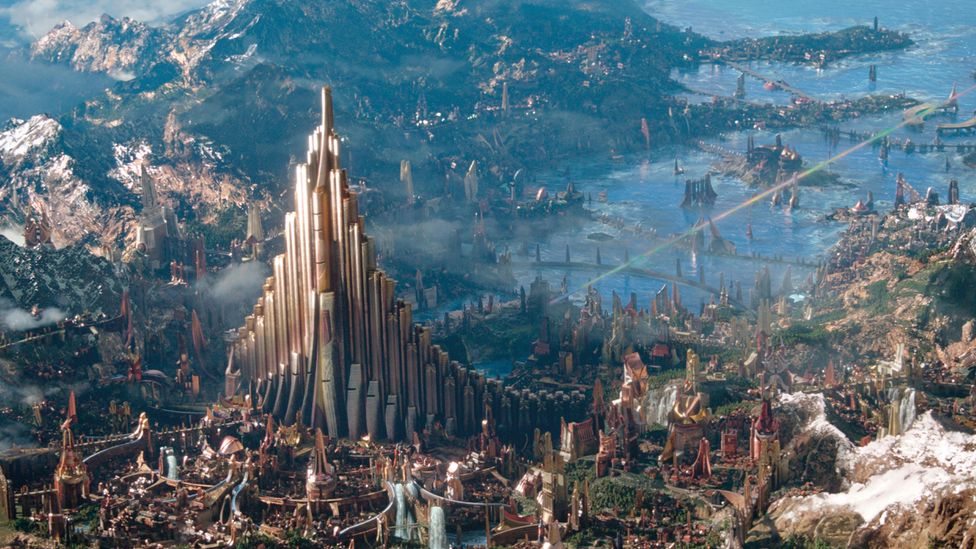
Asgard, as depicted in Thor: Ragnarok (Credit: Walt Disney Studios)
In Miklagaard – which some claim to have provided the visual cues for Asgard, the home of the Norse gods – it was possible for the Vikings to gain wealth and employment. Indeed, Vikings made up the vast majority of the Varangian Guard, protectors of the Byzantine Emperors between the 10th and 14th Centuries. During the early 11th Century, one of their number included Harald Hadrada, a name more famous for losing the battle of Stamford Bridge in 1066. Other guards may have been more laconic – in an eave of the great mosque Hagia Sophia in Constantinople, for example, runic graffiti from the 9th Century says the equivalent of "Halfan was here".
Kershaw's findings are referenced in Dr Cat Jarman's recent book River Kings, a sweeping, fascinating piece of archaeological detective work that explores these links further. The book begins with the discovery of an ornate bead found in a warrior's grave dating back to the time of the "Great Heathen Army" in Repton, Derbyshire, and reverse engineers the journey back to its source in Gujarat, India. While Vikings may not have even made it to India, this underlines the notion that not only was the East open to the Norsemen, but it was an area with which they proactively and extensively engaged.
According to Kershaw, the Vikings' movements in the East recast them as "part of a globalised network connecting empires". Such a wide trading operation would require the support of entire societies, in turn suggesting a much more central role for women in this "raiding economy". Kershaw notes that to now, "we've been resistant to the idea that women went with the Vikings to the West," seeing this instead as "a male event".
Yet the longevity of the Vikings would have been underpinned by the "almost industrial" work of women in creating sails, clothing, rope and other vital materials. While this may sound prosaic, it was integral to the Vikings' success, and there is also the suggestion that women were more directly involved in seafaring, exploration, and warfare during the period. For example, Dr Eleanor Barraclough's Beyond the Northlands traces the Vikings' journey from the edges of the Holy Land to the Americas through the old Sagas. In doing this, she highlights a wide range of female protagonists, including Gudrid Thorbjarnardóttir – known as víðförla ("well-travelled") – a woman with "light chestnut coloured hair" and "huge eyes" who is credited with being the first European to give birth in North America. Gudrid would later take a pilgrimage to Rome following Iceland's conversion to Christianity, and in Barraclough's estimation, she is the "real hero of the Vinland Sagas".
Alternatively, there's the fierce Freydís Eiríksdóttir, who, when faced with indigenous attackers in the Saga of Erik the Red, "let down her sark and struck her breast with a naked sword". Such a sight ensured the attackers "rushed off to their boats and fled away". Albeit more tenuously, the Eddas include the Valkyrie, an elite force of women soldiers who select which of the Viking war-dead deserve to join them in Valhalla. Recently brought to life in the 2017 Marvel film Thor: Ragnarok, their presence perhaps presupposes the involvement of women in warfare.
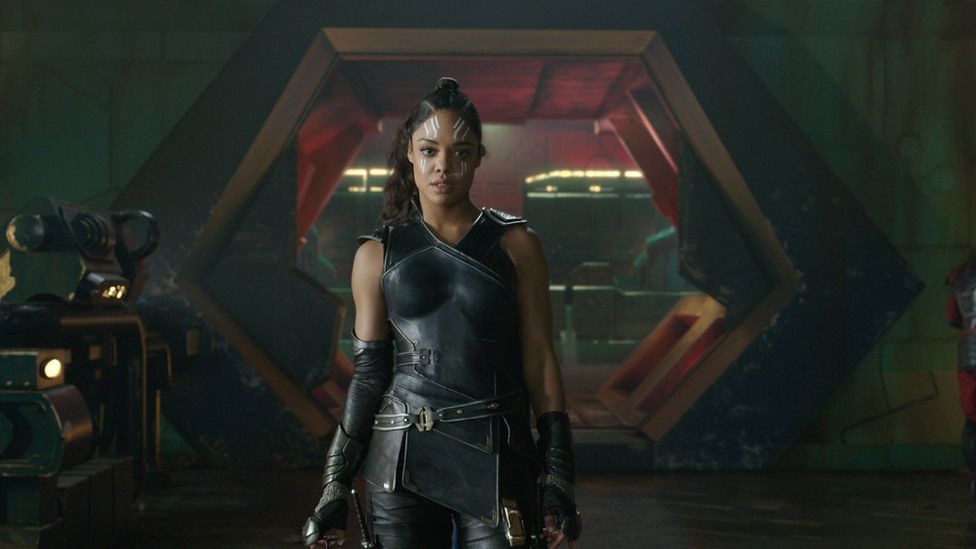
Tessa Thompson as Valkyrie in Thor: Ragnarok (Credit: Walt Disney Studios)
The Sagas and Eddas do not provide a straightforward history of the Vikings, but they do capture a Viking world that is deeper and broader than might previously have been appreciated – and which has been portrayed in much of Western popular culture until now. Not least, the role of women in the enduring legacy of the Vikings. As Kershaw concludes: "You need women to sustain cultural influence. Because it's women who pass on language to their children, who uphold cultural tradition and pass on religion. So, if you're looking for the mechanism for preserving Scandinavian culture abroad, you're probably looking at women."
While our historical perception of the Vikings might be changing, the cultural footprint they have left has been indelible. From the Northern reaches of Scandinavia, the Vikings have taken over the world's imagination, providing a mystical and bloodthirsty group whose visual flair and habits have been caricatured in hundreds of films, TV shows and books. In time, our evolving view of who the Vikings were and where they engaged may begin to afford this picture more nuance. But until then, Vikings: Valhalla will join a long line that brings this seafaring, ingenious and undeniably brutal people to life.
Vikings: Valhalla premieres on Netflix on 25 February.
Love film and TV? Join BBC Culture Film and TV Club on Facebook, a community for cinephiles all over the world.
If you would like to comment on this story or anything else you have seen on BBC Culture, head over to our Facebook page or message us on Twitter.
And if you liked this story, sign up for the weekly bbc.com features newsletter, called The Essential List. A handpicked selection of stories from BBC Future, Culture, Worklife and Travel, delivered to your inbox every Friday.
